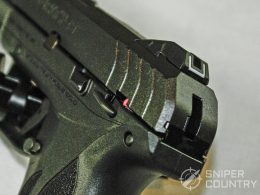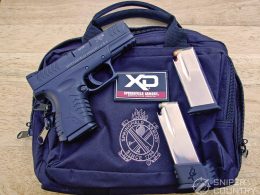Heckler & Koch makes some of the highest-quality arms in the world. From submachine guns to rifles to pistols, the company has earned a good reputation for tough, reliable weapons. I was blown away (not literally) with the quality and workmanship exhibited in the P30L in .40 S&W when I reviewed that gun a few months ago and the P2000 series guns are no exception. They are, pretty much, the same gun (at least on the inside). They even share an owner’s manual.
I was loaned a technically-used (but we don’t think it had ever been shot) P2000SK (sub kompact) to review by good friend Duane. He had one in his gun shop that he allowed me to take home for this write-up. Usually, if he has a used gun that is a trade-in (not a consignment), he’ll let me borrow it…he’s a good guy. (Not just for that…you gotta know him!)
So, I took the little guy home and put it through its paces. Let’s look at the gun first then the targets – we’ll end with a bit about the company.
The Gun
The P2000SK is the smaller version of the P2000. This HK pistol is the son, if you will, of the HK USP. The ergonomics were improved with the newer model. It was designed to reduce handling stresses while at the same time increasing comfort while handling and shooting.
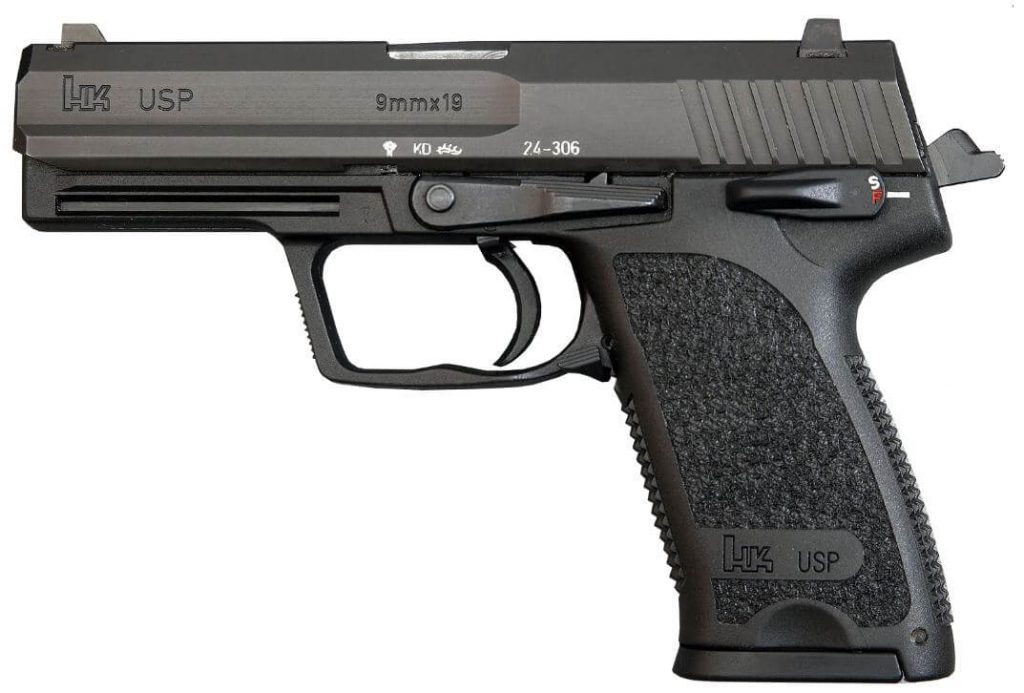
The USP was available in the calibers .40 S&W, 9mm, .45 ACP and 357 Sig.
The P2000 is based around a modified short-recoil Browning-type linkless cam action and a tilting barrel, like the USP.
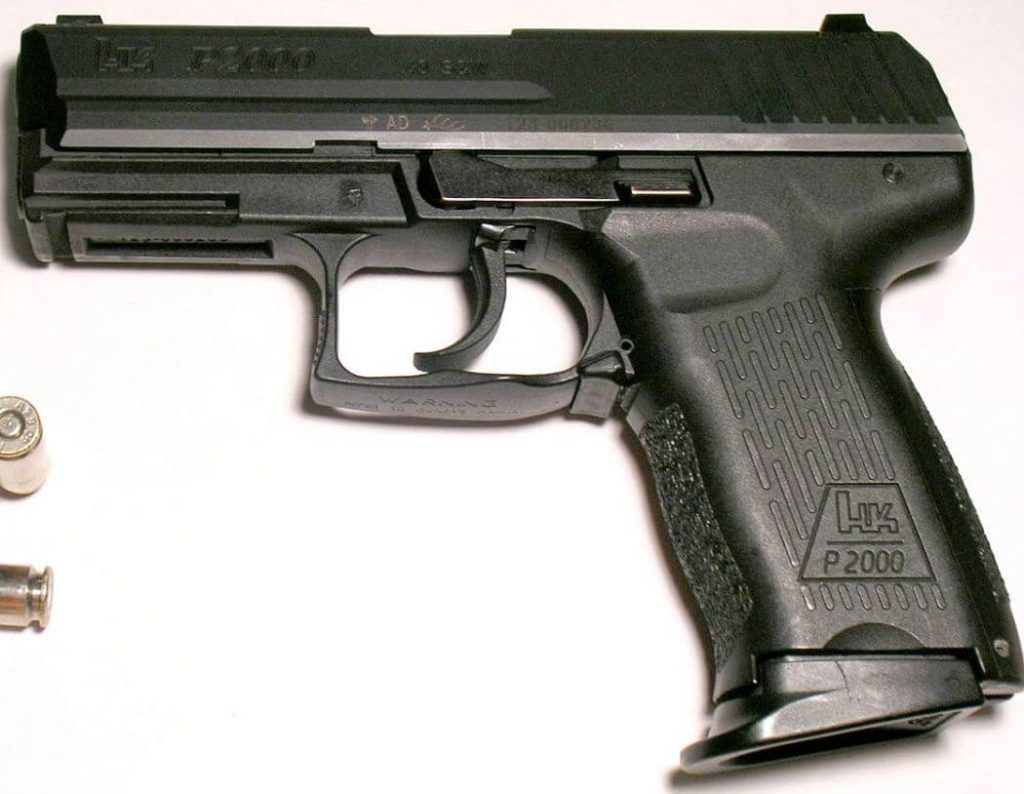
The “SK†version is simply a smaller P2000. Here’s a pic, then some specifications…
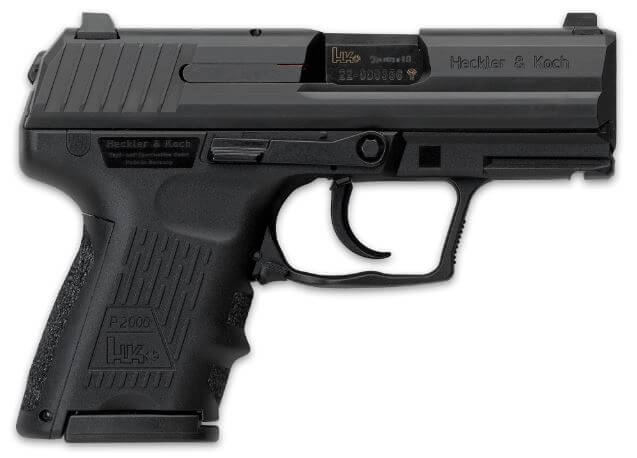
Specifications
| Caliber: | 9mm (.40 S&W also available) |
| Length: | 6.4 inches |
| Height: | 4.55 inches |
| Width: | 1.37 inches |
| Action: | Hammer-fired D.A.O., short-recoil |
| Barrel: | 3.26 inches |
| Barrel Rifling: | Polygonal |
| Sights: | Fixed night sights, "big dot" front |
| Magazine Release: | German paddle-style |
| Slide Release Lever: | Ambidextrous |
| Sight Radius: | 5.18 inches |
| Weight: | 24 ounces |
| Capacity: | 10 rounds - one flush-fit and one finger-extension magazine included (2) * |
| Trigger Pull Weights: | Single action - 4.5 pounds; Double action - 11.5 pounds |
| Double-Strike Capable: | Yes |
| Other: | One extra backstrap included |
| Country of Origin: | Germany |
Available Configurations
Here’s a screen shot from the HK site that explains all the ways you can get a P2000SK…they don’t skimp on making a large variety of models, to be sure.
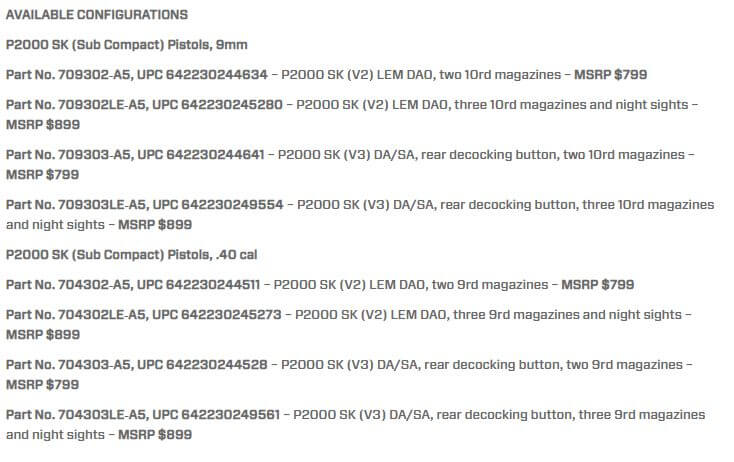
We see that this gun comes in several different flavors. The one I shot used the L.E.M.D.A.O. trigger – Law Enforcement Module, Double Action Only. What does that mean? Well, in my earlier P30L review, I spent some time talking about the DA/SA mode that that pistol uses, complete with a decocker button at the rear of the slide (the best place for a decocker, in my opinion). This pistol does not have that button, which makes it an L.E.M.D.A.O. version.
BONUS OFFER: Get your free shooting range targets to print at home!
Get your free targets to print at home!
L.E.M. Who-What?
The L.E.M.D.A.O. trigger is, without going all totally techno-geek, simply describes a D.A.O. trigger system whereby the hammer is partially pre-cocked, thereby requiring less pressure to activate it. In the specs we see that the first D.A. pull will be around 11.5 pounds with subsequent shots around 4.5 pounds. Now, we’re familiar with the CZ-style DA/SA triggers out there that will have a hammer-down pull of around 12-13 pounds then will go into SA mode once the hammer is cocked – my CZ variant SAR K2P does that and is a great shooter. The difference is, with the HK L.E.M.D.A.O. trigger, the hammer stays down – it’s DA all the time. The trigger pulls ARE lighter…I had a couple of shots let go as I was coming back down on the target, it’s that light. I will vouch for the fact that the trigger pulls in both first-shot DA and follow-up-shot SA are lighter.
Let’s look at what HK says about that trigger, from their site:
“The P2000 SK is available with Law Enforcement Modification (also known as Combat Defense Action) trigger system introduced in 2001 on the USP Compact “LEM†(Law Enforcement Modification) model. This unique pre-cocked hammer system combines the advantages of a cocked striker component (constant level of trigger pull and short trigger travel from first to last round fired) with a double action hammer system. The LEM/CDA trigger pull has been reduced to 7.3 – 8.5 pounds of pressure (32.5 – 37.8 Newtons), compared to 12 – 15 pounds (53.4 – 66.7 N) found on many conventional double action pistols. Optional adjustment by an HK certified armorer can bring the trigger pull into the 5.5 pound (24.5 N) range.
Using such an enhanced trigger system consolidates ease of use and safety into a convenient, innovative trigger operation — one that prevents unintended firing. And in case of an ammunition-related failure to fire, all that is needed is an additional second or third pull of the trigger without the need of first pulling the slide back to re-cock the Subcompact.â€
OK…we get it…the trigger pull has been lightened. Yeah, but that’s a pretty big deal. You who are revolver shooters appreciate a smooth, lighter DA pull – I know I do. And, if you run a 1911, you are most likely used to a crisp SA pull of around 4 pounds…this pistol does both of those, and does it well. I was truly impressed with the trigger…it was better than the trigger on the other HK I reviewed. But…it’s supposed to be. That’s the whole point.
Popular Articles
Let’s Take It Apart
I field-stripped the P2000SK into its major components – this was a pretty simple task. Here’s how:
- Remove the mag and check to make sure the chamber is empty…I forgot to do that once years ago and ended up with a hole in my bench. I know, I know…
- Retract the slide slightly, until the “hole†in the slide is lined up with the slide release lever’s axle
- Press the slide lever out R to L and remove
- Pull the slide off the front of the frame, no trigger press needed
- Remove the captive recoil spring and then the barrel. To reassemble, reverse this process. It takes longer to describe than to do.
Here are some pics…
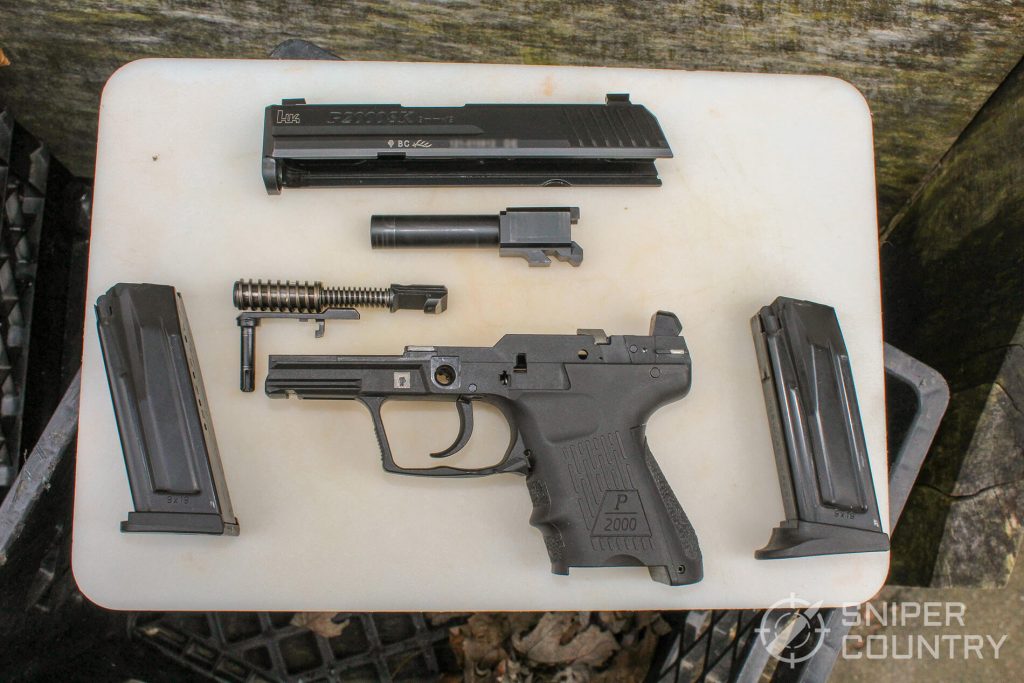
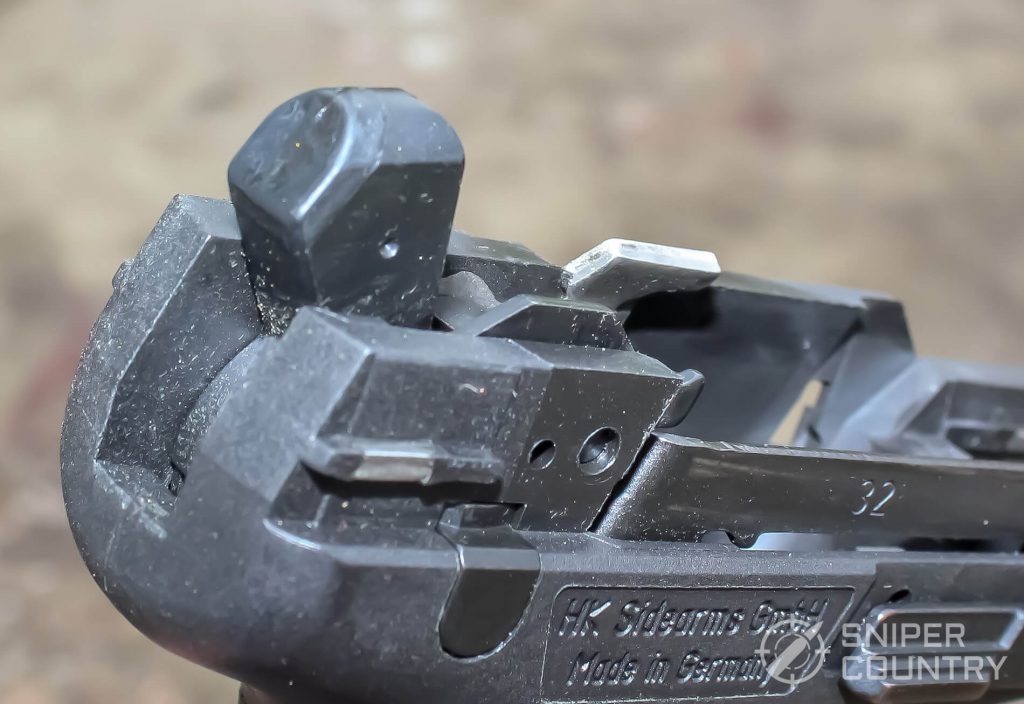
Note – no spur. It’s D.A.O., can’t cock the hammer by thumbing it back.

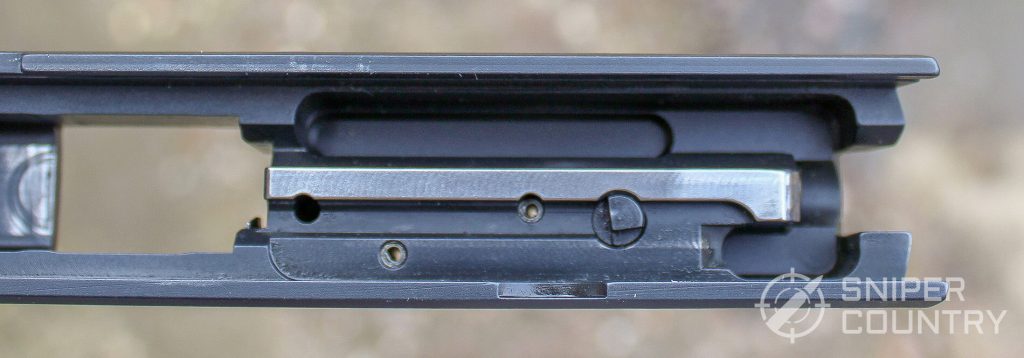

Here are a couple of shots of the grip areas…nicely done.
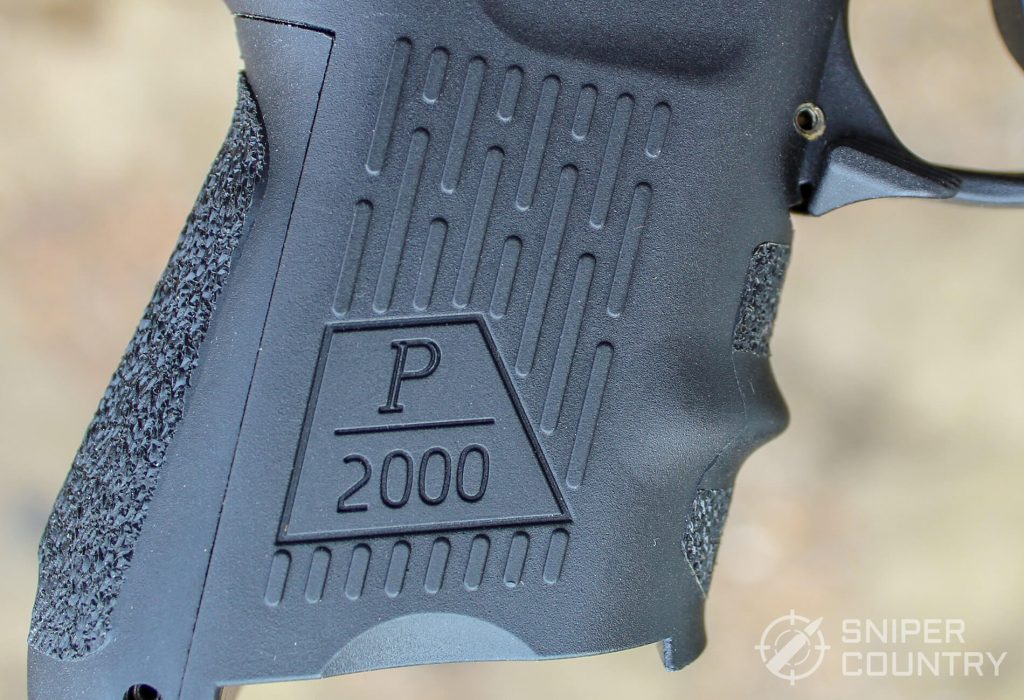
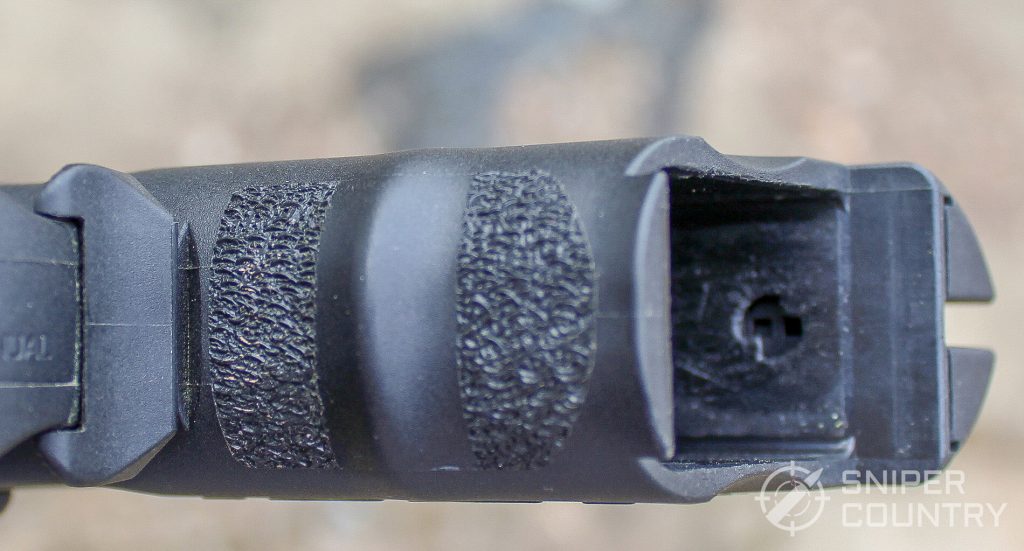
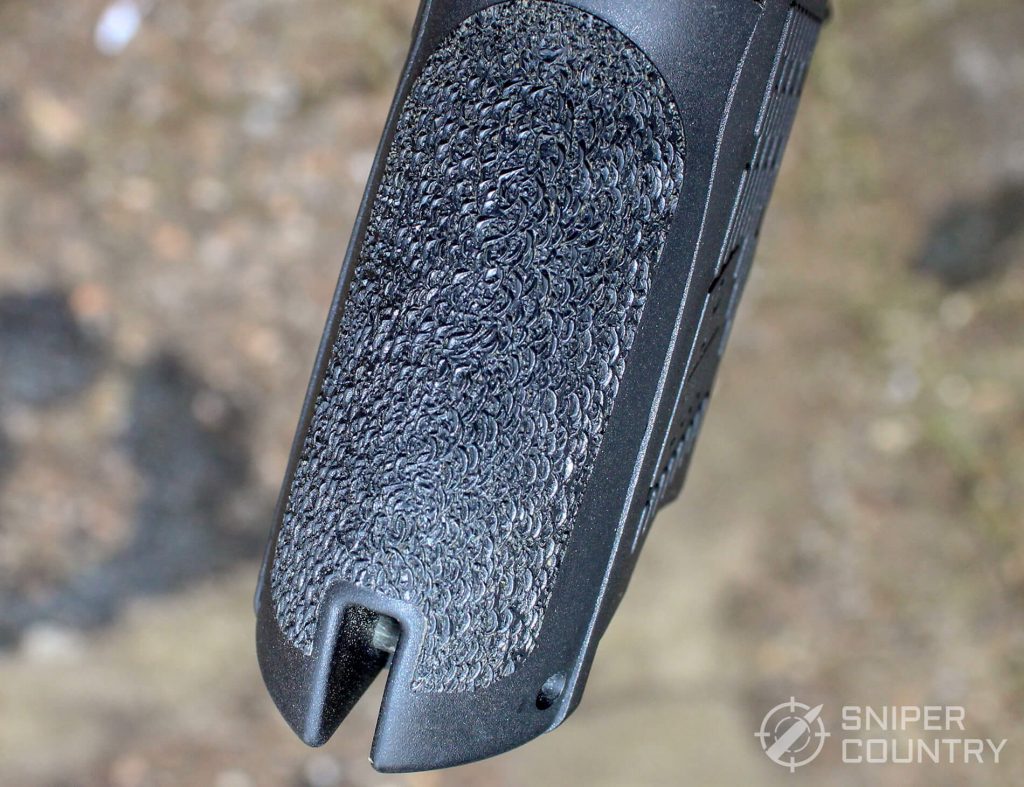
Those are the major pieces. Now, a word from this left-handed shooter about two of the reasons I REALLY like these HKs…
First, the magazine release. This gun, like most non-Americanized, truly-German pistols (Walther PPS M1, I’m talking to you!), uses the under-trigger-guard paddle release. This is a truly ambidextrous way of addressing how to drop the magazine. No matter if you are right-handed or wrong-handed, it works. I was popping the mag out without having to think about it.
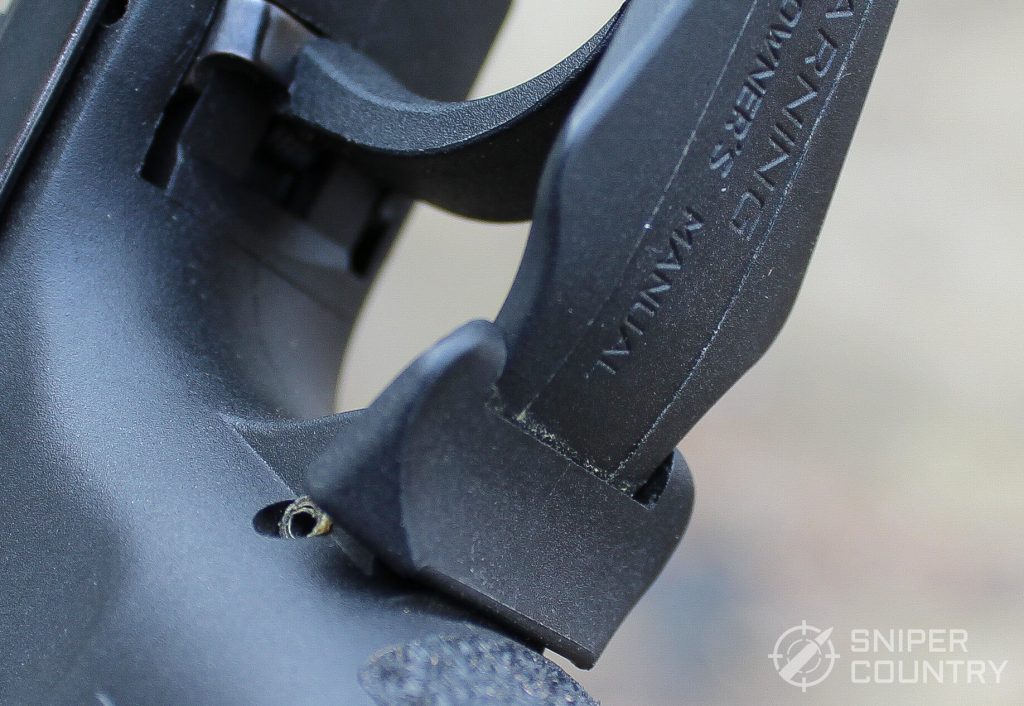
Here are a couple of shots of the P30L’s mag release…it’s identical to the one on the P2000SK.
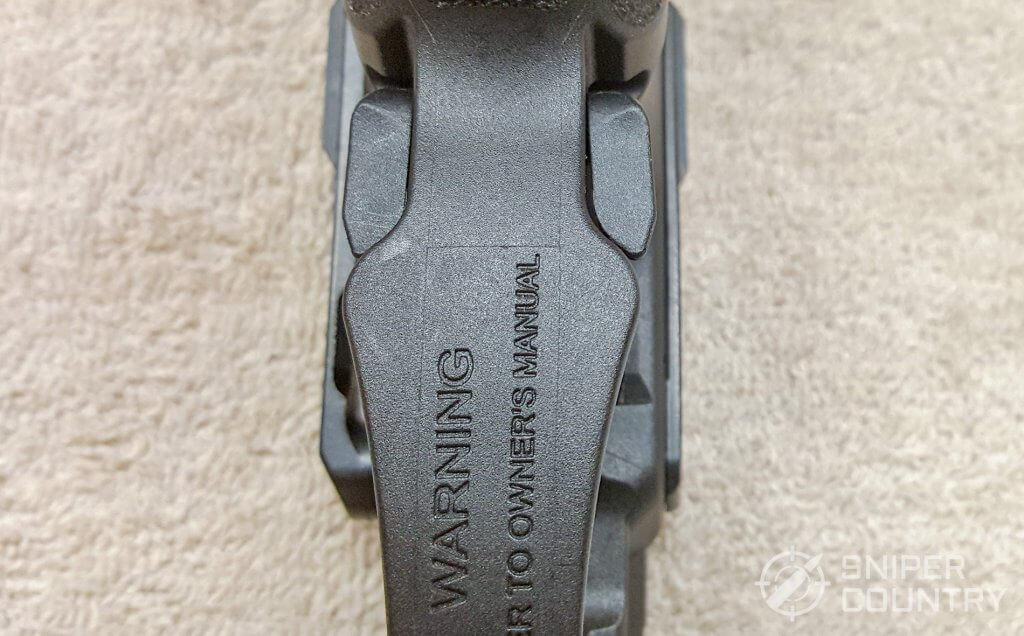
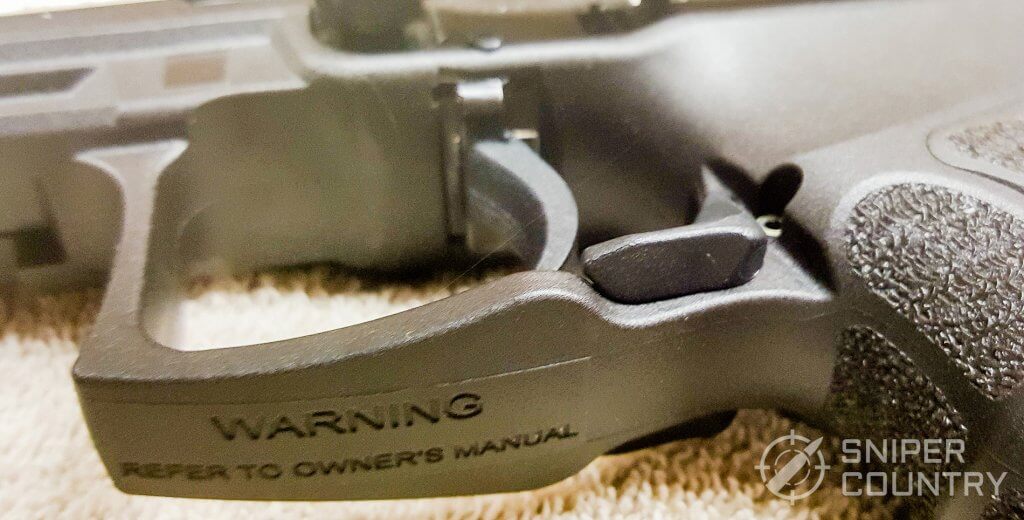
As you can see, this mag release is easy to use from either side. The other thing I like is the ambi slide release…
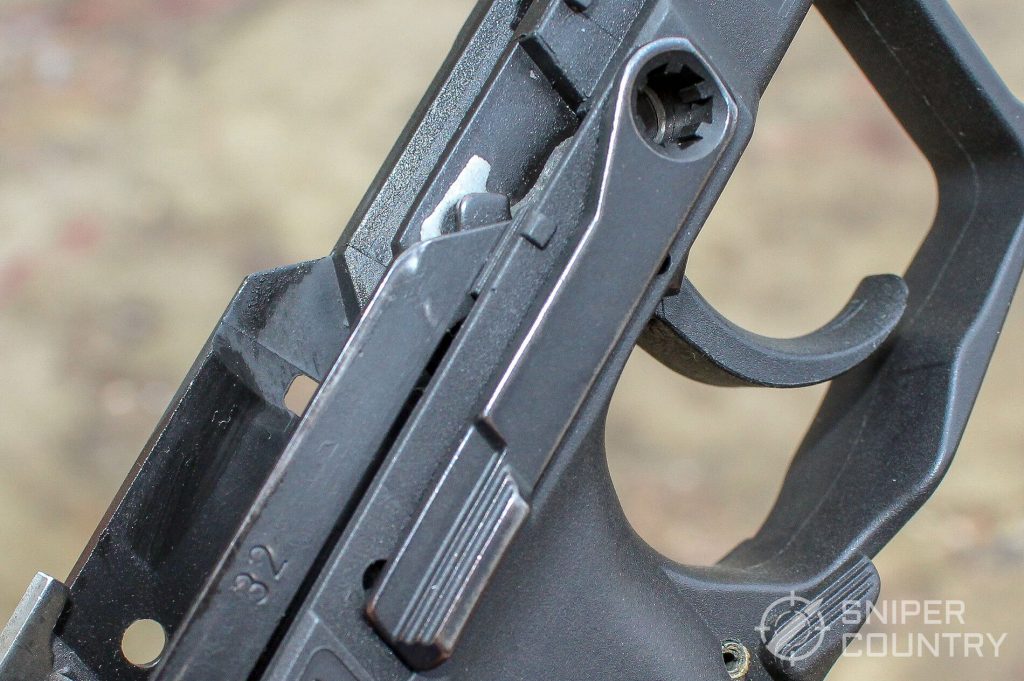
Here it is on the right side of the gun. You can see the “void†where the pin has been pushed through in order to remove the slide. Another thing that impresses me is the length of the lever that HK puts on its slide release…the length gives you more leverage when you press down on it, making it easier to release the slide. Good ideas, HK.
BONUS OFFER: Get your free shooting range targets to print at home!
Get your free targets to print at home!
Shooting The P2000SK
I went through a lot of ammo when I tested this gun. I am not supported by Federal or any other ammo company so what I shot was what I had on hand…the Winchester “white box†115-grain factory load and lots of my favorite 9mm handload, a cast 124-grain (powder coated) Lee round nose over 4 grains of Long Shot powder. I didn’t shoot any defense ammo. Here are a couple of ballistic numbers from these two loads…
| Velocity | Energy | |
|---|---|---|
| WWB 115-Grain | 1084 | 300 |
| My Handload | 1037 | 301 |
This proves nothing, other than what these two loads did in this particular gun. I only include them because some of you are a whole lot like me – I want to know how a shorter barrel handles different loads. I don’t need to run 40 different loads through this gun, because in this day & age we have ammo optimized for short barrels that is very effective. You would be well-served to run your favorite defense load(s) through this gun and be confident in its performance. There are a bazillion You Tube videos of guys (who have more time on their hands than I do) testing 9mm ammo in ballistic gel/milk jugs/denim layers/hippopotamus hides (OK, I jest)/ etc. Suffice it to say, this gun was accurate and reliable. Here are a couple of the targets I shot…
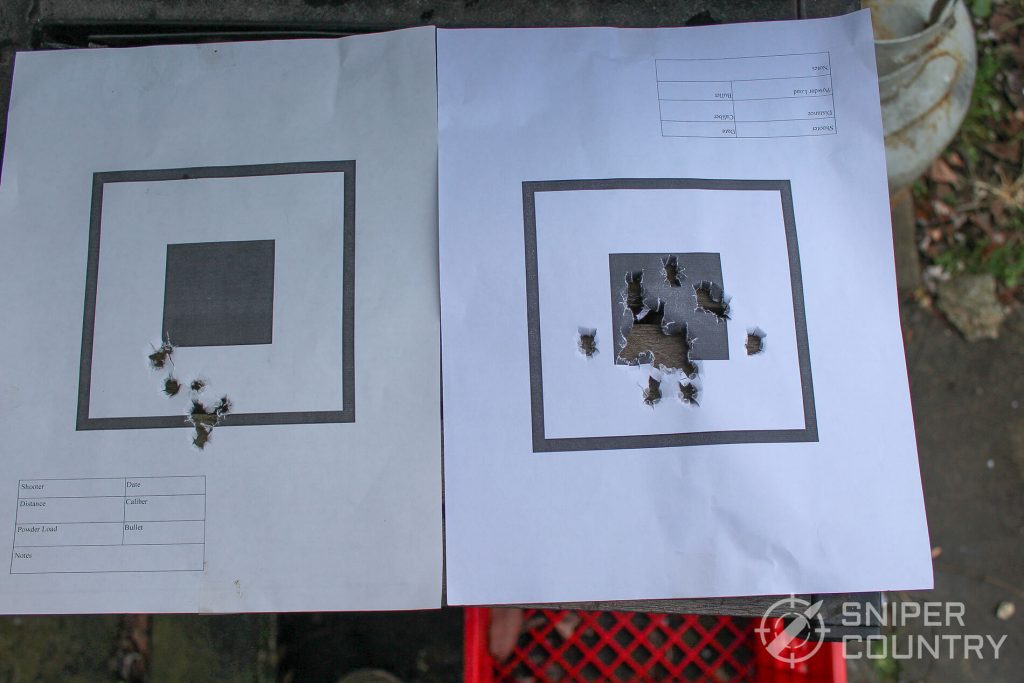
You will see that both targets show a decent group. Mine shot a bit low, with the WWB mostly centered on the target. The left target shows 10 rounds, while the right shows 20. I fired offhand, standing, at 10 yards. A Jerry Miculek I’m not, so take these targets with a grain of salt…
When I review a gun like this one – a solid performer with an excellent reputation and “street cred†– I don’t worry too much about whatever targets I shoot with it. Really, the only reason I included these targets is so that you would know I did actually shoot this gun. And, shoot it I did. I put dozens of my loads through it and many factory loads. Why, if I didn’t really need to do that? Because – it was a fun gun to shoot. Simple. I like to shoot, and I can shoot in my back yard out to 100 yards or so, so it’s quick and easy to do. I took advantage of shooting a gun that has an MSRP of $799. I shot both the flush-fit and the finger-extension magazine. I preferred the longer one.
If you’ve not shot an HK pistol, you need to track one down – it’s a high-quality item, Clark.
Before we end, let’s look at the company and a bit of its backstory…you can check out my previous article and the history of HK that I included therein. It’s an interesting read. It describes how three former Mauser engineers in Oberndorf, Germany took something out of the ashes of WWII and formed what was to become one of the most competent, in-demand weapons manufacturing companies in the world. It is worth a look.
And, In The End…
I’m sorry I have to give this little guy back. It fits my hand very well, shoots easily and is accurate. With its 10-round capacity, it isn’t going to win any huge-double-stack competitions, but it is one very solid gun. The trouble with so many double-stack guns that hold more than 10 rounds is that they can be very wide in the hand, wider and heavier. This gun is 24 ounces, empty, and a bit over an inch wide. It would sit well in an IWB holster. My only complaint, if you could call it that, is that the gun is awfully short in my average-size hand. I get it – it’s supposed to be a concealed-carry gun, so it’s not too tall. I just had trouble getting more than two fingers on it with the flush-fit baseplate magazine inserted. The finger-extension mag was marginally better – at least I could get two-and-a-half fingers on it. This is a small quibble…it IS, as I just said, a concealed-carry gun and is proportioned accordingly. I do really like it.
Here’s an impromptu score…1 to 5 stars:
Build Quality: âââââ
Concealability: âââââ
Ergonomics: ââââ ½
Value: âââââ
Shootability: âââââ
I checked online with a couple of sellers and this gun was out of stock – no wonder. Even though it isn’t bargain-basement-priced, it’s a very solid value. This is one gun that will hold its value down through the years. If you are looking for a carry gun in 9mm or .40 S&W, give this little guy a look (don’t forget to check out CCW insurance). I know where there is a like-new used one in a gun case that is priced right…hopefully, you’ll find one, also. As always, thanks for reading – please leave a comment below. Now, get out there and go shoot, but…be safe!

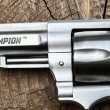
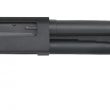


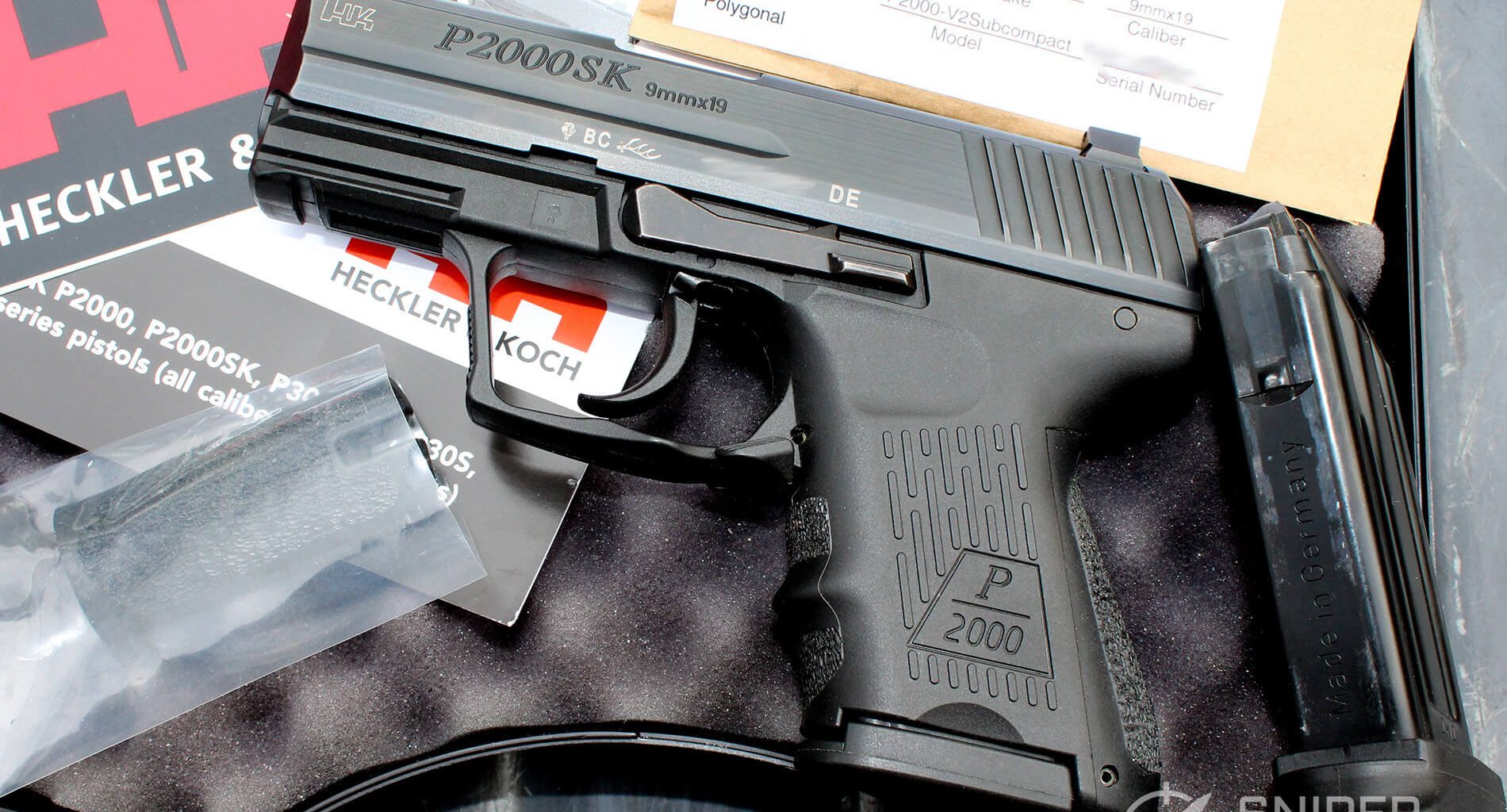
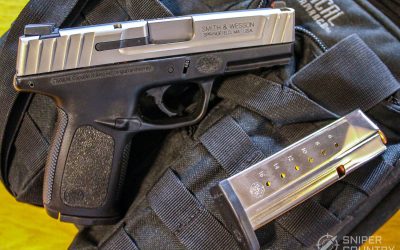

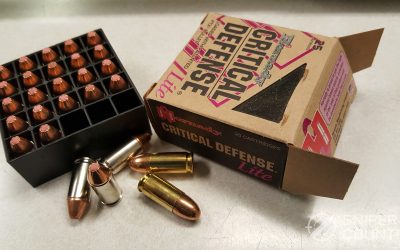

![9mm Glock Models [Ultimate Guide]](https://www.snipercountry.com/wp-content/uploads/2018/10/Glock-17-vs-Glock-19-vs-Glock-26-vs-Glock-41-vs-Glock-43-WM-400x250.jpg)
![Handgun Caliber Chart [2025 Ultimate Guide]](https://www.snipercountry.com/wp-content/uploads/2018/10/Handgun-Caliber-Comparison-400x250.jpg)
![Rifle Calibers [Ultimate Guide]](https://www.snipercountry.com/wp-content/uploads/2018/12/Header-1900-400x250.jpg)

